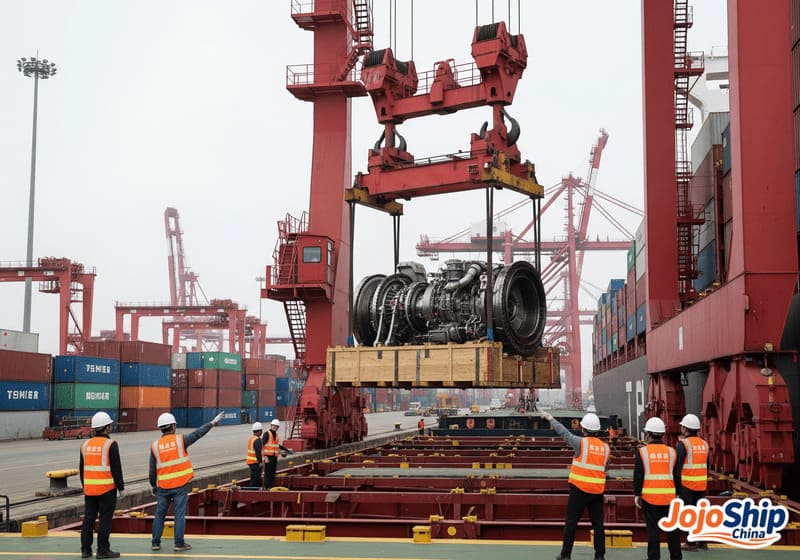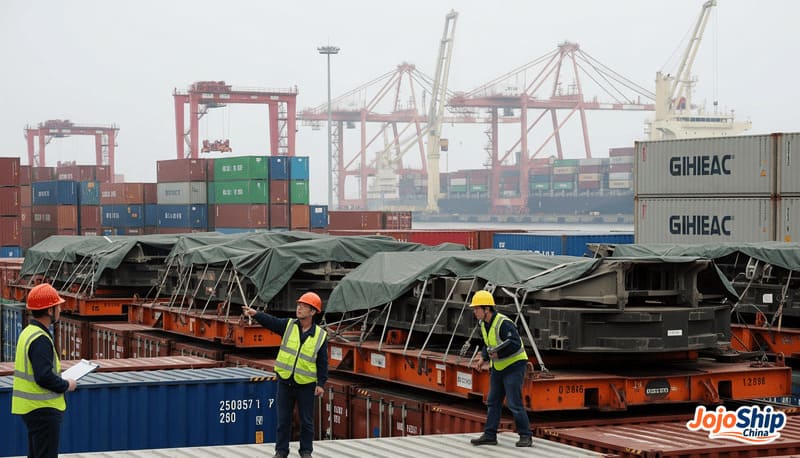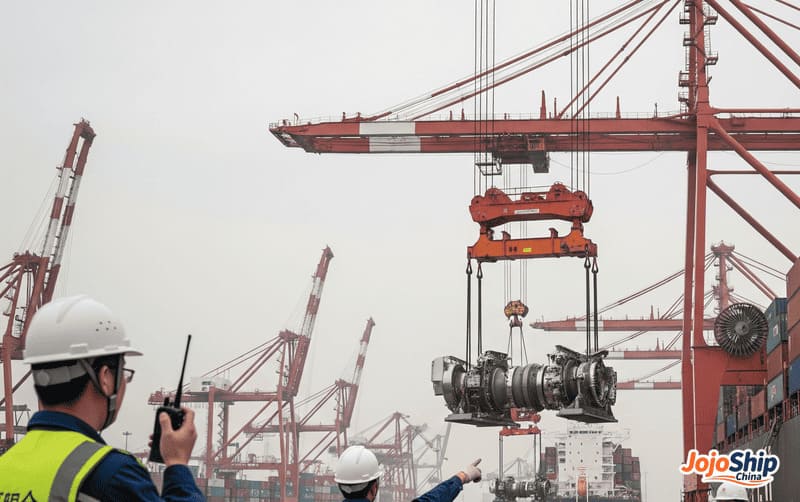Shipping heavy machinery or industrial equipment from China can be a logistical nightmare with astronomical costs. Finding specialized heavy cargo logistics providers could save you thousands while ensuring your valuable cargo arrives intact and on time.
The best logistics providers for heavy cargo shipping from China to the US are Swire Projects, Winsky Freight, C.H. Robinson, Maersk, and JojoShip China. These companies specialize in handling oversized, breakbulk, and project cargo with dedicated equipment, specialized vessels, and end-to-end service capabilities.

I still remember helping a manufacturing client who needed to ship a 25-ton machine from Ningbo to Chicago. Their regular shipping partner quoted an astronomical price and couldn't guarantee safe handling. By connecting them with a specialized heavy cargo forwarder, we cut their costs by 30% and delivered the equipment without a scratch. Let me share what I've learned about the best options for your heavy shipments.
What Is the Best Shipping From China to USA?
When shipping heavy cargo, choosing the wrong method can lead to damaged goods, unexpected costs, or weeks of delays that impact your entire supply chain.
The best shipping method for heavy cargo from China to USA is ocean freight using specialized equipment such as flat racks, open-top containers, or break-bulk vessels. For time-sensitive heavy shipments under 5,000 kg, air freight with main deck capacity may be suitable despite higher costs.

Comparing Heavy Cargo Shipping Methods
Not all shipping methods are suitable for heavy cargo, and choosing the right approach depends on your specific requirements, budget, and timeline. Based on my experience managing thousands of shipments from China, I've compiled this comparison to help you make an informed decision.
| Shipping Method | Best For | Weight Capacity | Transit Time | Cost Level | Special Features |
|---|---|---|---|---|---|
| FCL - Flat Rack | Oversized machinery | Up to 45 tons | 25-40 days | $$$ | Open sides/top for irregular shapes |
| FCL - Open Top | Tall equipment | Up to 27 tons | 25-40 days | $$$ | Removable top for loading by crane |
| Break-bulk | Extra-large cargo | Unlimited | 30-45 days | $$$$ | Direct vessel stowage, no container |
| RO/RO | Vehicles, wheeled equipment | Vehicle-dependent | 30-45 days | $$$$ | Roll-on/roll-off loading |
| Heavy-lift Vessels | Project cargo | Up to 2,000 tons | 35-50 days | $$$$$ | Specialized cranes and deck space |
| Air Freight | Urgent heavy shipments | Up to 10 tons | 5-8 days | $$$$$$$ | Fastest option for critical machinery |
| Sea-Air Combination1 | Time-sensitive heavy goods | Up to 10 tons | 12-18 days | $$$$ | Balance of speed and cost |
When I managed the shipment of construction equipment from Shanghai to Los Angeles, we chose flat rack containers2 because the excavators exceeded standard container dimensions. This allowed for secure lashing while keeping costs reasonable. The equipment manufacturer initially wanted to use air freight to meet their deadline, but the weight made that option prohibitively expensive.
It's important to understand that heavy cargo doesn't just mean weight—it often involves oversized dimensions that require specialized handling. For example, I once coordinated a shipment of industrial printing presses that weren't extraordinarily heavy but were over 3 meters tall. We used open-top containers and worked with a forwarder who specialized in this type of cargo to ensure proper loading and securing.
Break-bulk shipping has seen a resurgence for ultra-heavy cargo, especially with the spike in container rates over the past few years. This old-school method involves loading cargo directly onto the ship without containers, which works well for items like large transformers or industrial boilers that simply can't fit into any container type.
Who Is the Logistics Company From China to USA?
With so many logistics providers claiming to handle heavy cargo, it's difficult to identify those with genuine expertise and the necessary equipment for these challenging shipments.
Top logistics companies specializing in heavy cargo from China to USA include Swire Projects for breakbulk services, Maersk and COSCO for flat rack containers, C.H. Robinson for project logistics, Kuehne+Nagel for heavy-lift cargo, and JojoShip China for door to door heavy equipment transport.

Specialized Capabilities of Top Heavy Cargo Logistics Providers
Each logistics provider has different strengths when it comes to heavy cargo. Understanding their specialized capabilities will help you choose the right partner for your specific shipment needs.
| Logistics Provider | Headquarters | Specialization | China Coverage | US Destinations | Key Advantage |
|---|---|---|---|---|---|
| Swire Projects | Hong Kong | Semi-liner services with dedicated heavy-lift vessels3 | Major ports + inland | West Coast ports | Purpose-built vessels for project cargo |
| Maersk | Denmark | Global carrier with specialized equipment | Comprehensive | All major ports | Extensive flat rack and open-top inventory |
| C.H. Robinson | USA | Project logistics and oversized cargo | Major industrial zones | Nationwide | Strong last-mile delivery network |
| Kuehne+Nagel | Switzerland | Heavy-lift and industrial projects | All regions | Coast-to-coast | Integrated customs and compliance |
| JojoShip China | China | Door to door heavy equipment transport | North and South China | All US regions | Direct supplier coordination in China4 |
| Ocean Star International | China | RO/RO and flat-rack specialists | Eastern seaboard | Multiple ports | Industrial machinery expertise |
| Winsky Freight | China | FCL and oversized cargo | Major manufacturing zones | West and East Coast | Strong Chinese domestic network |
| ZGGShip | China | Containerized heavy freight | South China focus | California ports | Competitive rates for standard heavy cargo |
Having worked closely with many of these providers, I can tell you that their real-world performance often differs from what their marketing materials suggest. For example, when I needed to ship heavy manufacturing equipment from Guangzhou to Detroit, JojoShip China proved invaluable because of their ability to coordinate directly with the Chinese supplier and manage the complex loading process in the factory.
For another client shipping mining equipment from northern China to Houston, Kuehne+Nagel's project cargo division provided comprehensive solutions including engineering studies to ensure the cargo would be properly secured5 during ocean transit. Their attention to detail prevented potential damage to a $2 million piece of equipment.
The key differentiator I've noticed among heavy cargo specialists is their investment in specialized equipment and trained personnel. Companies like Swire Projects maintain their own inventory of spreader bars, specialized slings, and custom cradles designed specifically for unusual cargo shapes. This equipment makes all the difference when loading items that can't be handled by standard container terminal gear.
Another crucial factor is the provider's relationship with specialized carriers. When shipping oversized cargo, you need carriers with the right vessels and equipment. The best logistics providers have established relationships and blocked space agreements with carriers operating heavy-lift vessels or those with substantial flat rack and open-top container inventories.
How Long Does a Cargo Ship Take From China to the USA?
Transit time uncertainty can create major problems when shipping heavy equipment that may be needed for time-sensitive projects or production schedules.
A cargo ship carrying heavy freight typically takes 14-18 days from China to the US West Coast and 30-35 days to the East Coast. However, for specialized heavy-lift vessels or breakbulk shipments, transit times can extend to 30-45 days due to less frequent sailings and multiple port calls.

Factors Affecting Heavy Cargo Transit Times
Understanding the variables that impact shipping times for heavy cargo will help you plan more effectively and set realistic expectations for project timelines.
| Factor | Impact on Transit Time | How to Mitigate |
|---|---|---|
| Port of Origin6 | Varies by 1-5 days | Choose ports with frequent heavy-lift vessel service |
| Destination Port | Varies by 1-7 days | Consider ports with specialized heavy cargo facilities |
| Vessel Type | Standard container: faster Heavy-lift: slower | Book early for specialized vessels |
| Cargo Dimensions | Extra-large requires special handling | Pre-plan loading/unloading requirements |
| Equipment Availability7 | Flat rack/open-top shortages can cause delays | Reserve equipment 4-6 weeks in advance |
| Customs Clearance8 | Complex machinery needs detailed documentation | Prepare detailed technical specifications early |
| Inland Transportation | Oversized loads need permits | Use logistics providers with established routes |
| Season | Q3-Q4 typically see longer transit times | Ship during Q1-Q2 when possible |
Based on my experience managing heavy cargo shipments, I've found that transit time variations can be substantial. For example, I once coordinated two similar shipments of manufacturing equipment, one from Shanghai and one from Dalian. Despite being roughly the same distance from the US, the Dalian shipment took an additional 12 days because heavy-lift vessels call at that port less frequently.
Another critical factor is port selection in the US. Heavy cargo often requires specialized port facilities with appropriate cranes and handling equipment. Ports like Houston and Baltimore have excellent heavy-lift capabilities, but if your cargo is destined elsewhere, you'll need to factor in additional time for inland transportation, which is often the most complex part of the journey for oversized items.
Weather can also significantly impact heavy cargo shipments. When a client was shipping wind turbine components, we had to build in extra buffer time because these flat rack shipments are particularly susceptible to weather delays. The open nature of flat racks means ships carrying them may need to alter course to avoid rough seas that could damage or destabilize the cargo.
Pre-planning is essential for heavy cargo shipments. At JojoShip China, we typically start the planning process 2-3 months before the actual shipping date for significant heavy cargo projects. This includes engineering studies, route surveys, equipment reservations, and coordination with specialized carrier sailing schedules that often operate monthly rather than weekly like standard container services.
For time-sensitive heavy shipments, I sometimes recommend a hybrid approach9. We've successfully shipped machine components that could fit in standard containers via regular service, while sending only the oversized portions via specialized vessels. This parallel shipping strategy can reduce overall project timelines by weeks in some cases.
Conclusion
The best logistics providers for heavy cargo shipping from China to the US include specialized companies like Swire Projects, Maersk, C.H. Robinson, and JojoShip China. When selecting a provider, consider their specialized equipment, port relationships, and door-to-door capabilities to ensure your valuable heavy cargo arrives safely, on time, and within budget.
-
Learn how combining sea and air freight can optimize delivery times and costs for heavy cargo that needs to arrive quickly but affordably. ↩
-
Discover how flat rack containers accommodate irregularly shaped cargo, providing secure lashing and flexibility for large equipment shipments. ↩
-
Learn how specialized vessels can ensure safe and efficient transport of oversized and heavy cargo across the ocean. ↩
-
Find out how direct coordination with suppliers in China can simplify the shipping process and reduce risks for heavy equipment. ↩
-
Explore how engineering studies help prevent damage and ensure the safety of valuable equipment during international shipping. ↩
-
Discover why choosing the right port of origin can save days on your shipment and how frequent vessel service matters for heavy cargo. ↩
-
Understand how shortages of flat rack or open-top equipment can delay shipments and how early reservation can help you avoid costly setbacks. ↩
-
Find out how detailed documentation and technical specifications can streamline customs clearance for heavy and complex cargo. ↩
-
Learn how combining standard and specialized shipping methods can optimize delivery schedules for time-sensitive heavy cargo projects. ↩




